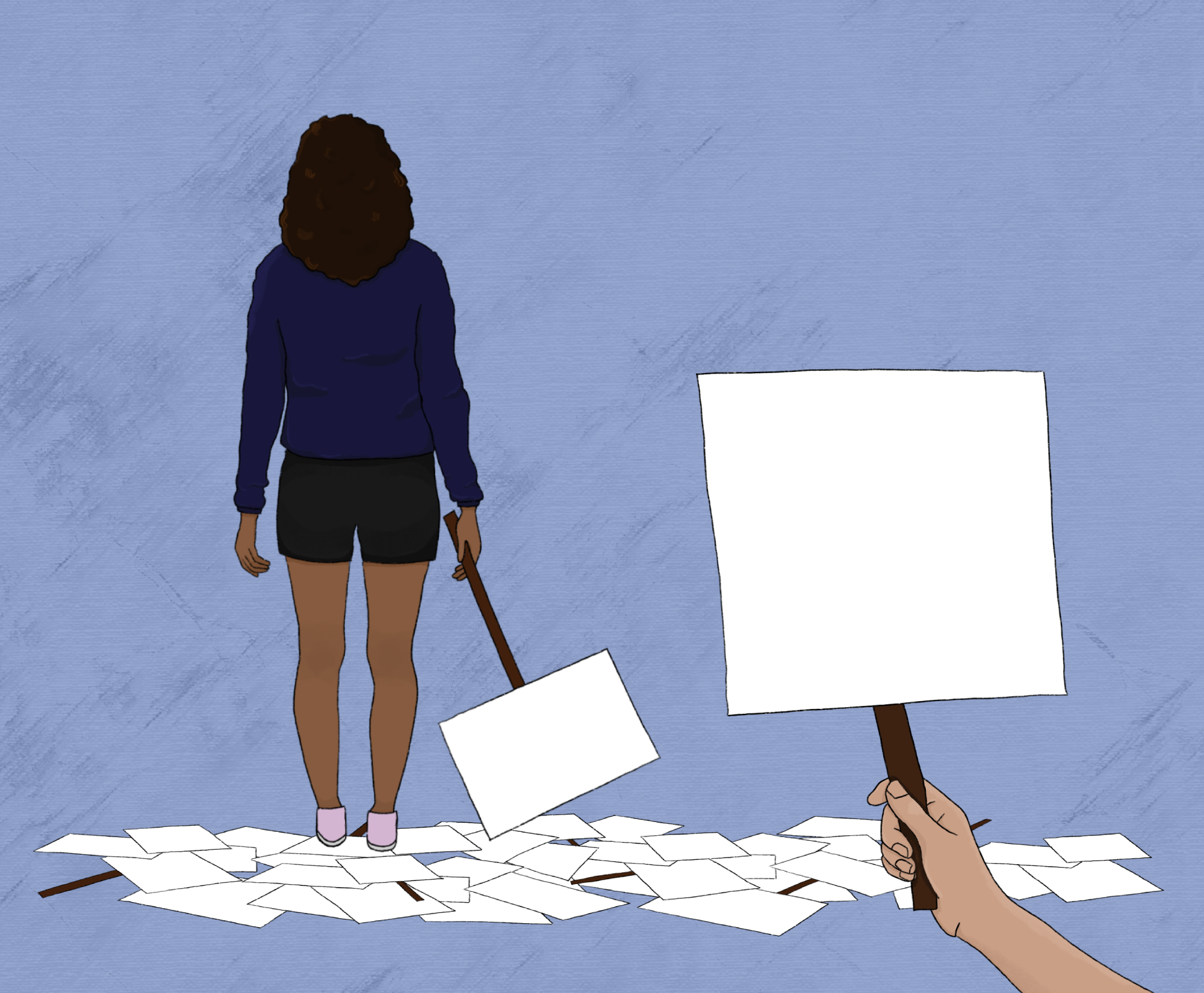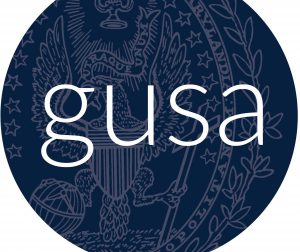Content warning: This article references sexual assault and police brutality.
Nile Blass (COL ’22) is, by her own words, tired and ready to graduate.
It’s hard to describe the entirety of Blass’ long standing community involvement: She is the current president of the Black Students Association (BSA); former president of GUSA; one of the founding members of the Black Survivors Coalition (BSC); and a leader in the movement for slavery accountability and reparations on campus, known colloquially as GU272 (and now HASA).
“Really tired,” she said.
After two years of constant stressors due to a global pandemic, everyone is tired. For the activists on campus, who organize for increased student resources and university accountability, exhaustion is pervasive. While the pandemic has taken its toll on everyone, the extent that Georgetown’s student leaders are overburdened seems disproportionately heavy. A handful of invested students seem to shoulder a great deal of the responsibility relative to the community at large, often with little institutional support.
“I don’t think all of this work needs to be in the hands of the people who are affected by these issues. I think one thing Georgetown really lacks is allyship,” Rowlie Flores (COL ’22) said.
Flores has been involved with GUSA for the past four years, most recently as vice speaker of the senate, advocating for students and coordinating with administrators, many of which are no longer at Georgetown. He pointed out that student efforts have only been complicated by high rates of staff turnover and a majority white student body that rarely actively seeks out opportunities to support BIPOC organizers.
“We need people who are actually willing to put down themselves with us, as equals, and even maybe as more than equals willing to put in the work,” Kayla Edwards Friedland (COL ‘22), a central organizer in the BSC, said. “That is their responsibility.”
Blass agreed, pointing out that most on-campus allyship exists within different BIPOC communities. “There’s a lack of engagement when things don’t directly impact you,” she said. “Oftentimes, the allyship is cross-sectional between marginalized communities.”
And despite the tireless work of marginalized student activists, so much moved backward over the past two years. The pandemic compromised the institutional memory and relational connection of many organizing networks on campus. Now, the work of activists risks losing its continuity.
“What do organizers do when there is no community to work with? How do you organize in an environment where their community dies, fragmented, broken?” Rimpal Kaur Bajwa (COL ’22) asked, reflecting on lost momentum after the pandemic.
Kaur Bajwa helped found the Georgetown Sikh Students Association and serves as the activism committee co-leader for Hoyas for Immigrant Rights. After four years being involved in immigrant rights spaces, she’s exhausted, and feels like no one is talking about it.
“No one talks about how draining it can be,” she said. “Activism is hard in just normal times. And then on top with a pandemic, it becomes that much harder.”
Community organizing draws heavily on emotional labor. At its core, the work involves nudging those with privilege to care enough to institute policies that better the material circumstances of the most marginalized. At Georgetown, this usually manifests in confronting administrators as well as white, wealthy students in ways that place already vulnerable people in dangerous and burdensome positions.
Movements like the BSC, which staged a Healy Hall sit-in in February 2020 to demand greater institutional support for sexual assault survivors, particularly Black students, had some success bridging the divide between affected students and the administration, who often completely disregard organizer demands, as well as with white students, who can be oblivious to issues. The hire of more Black clinicians of color, expanded SafeRide hours, funding for SAPE student employees, and increased funding for off-campus mental health marked a significant step in the right direction as a direct result of Black student activism.
But February 2020 was also the last month the whole student body would be on campus until fall 2021. Blass has seen how these successes come at a cost, “I think there was a lot of triumph in those spaces. I think there was a lot of community, but it’s just exhausting,” she said.
According to Friedland, the gap of time since students were last organizing in person has been detrimental to the momentum of specific movements. The physical distance from campus has also distanced organizers and the students they were able to engage from the work.
“The overall thing that’s been lost over the past few years is a real connection to particular efforts on campus,” Friedland said. “It’s just been a lot of distance. Distance kind of fosters complicity.” Friedland helped found BSC upon arriving at Georgetown and organized more broadly in D.C. after the murder of George Floyd and the protests that followed in 2020.
Organizing work on our campus already relies on a few individuals, meaning the burden of its emotional labor continually falls to a small group of people—most of whom are engaged in this work out of sheer survival.
“When I started organizing with all these things, is because there was an immediate, honestly, survival need that was not being met. And I wanted to do that,” Eric Pérez (COL ’23) said. Perez helped push for the Disability Cultural Center and has been involved with BSC, GU272, and GUSA throughout their time at Georgetown, among other efforts.
Still, even efforts surrounding critical needs can feel unsustainable. “Even if it is my own survival need that I’m fighting to address, is the advocacy worth it? It’s grinding me into the ground like this every day,” they said.
According to Siena Hohne (COL ’22), former co-president of GU Pride, the pandemic not only disrupted the kinds of organizing connections that could be formed but also prevented students from getting involved with organizing to begin with.
“You can reach out to as many people as you want saying, ‘run for X board,’ but you can’t change the material circumstances of their lives that prevent them from having the time or energy to do that,” Hohne said. “A lot of us upperclassmen have been in survival mode. Beyond even organizing, we’ve just been focused on ‘how do we get through college.’”
Victoria Boatwright (COL ’22), who has been heavily involved with climate organizing, founding the Georgetown Renewable Energy and Environmental Network (GREEN), and pushing the university to divest from fossil fuels as a part of GU Fossil Free (GUFF), notes that even in groups like GREEN and GUFF, which don’t have hierarchical structures, certain students become overburdened.
She agrees that much of what has been lost is the ability to pass down knowledge, responsibility, and membership to a new, widespread generation of campus organizers.
“For some initiatives, it’s been momentum,” Boatwright said. According to her, GREEN struggled with mentorship and leadership during the pandemic; however, since returning to campus, engagement has bounced back.
She does see glimmers of hope.
“As somebody who’s leaving and looking back and was worried during COVID of will we be able to get back on our feet,” Boatwright said, “I can definitely see that we’re walking, and we’re starting to jog and to run again.”
“I think that I’m really excited to see that other people have that spark in them,” she added.
But even if student engagement begins to tick up again, the relationship between student organizers and administrators, many have noted, has deteriorated.
“We lost a lot of admin that really supported students,” Flores said, explaining that students are dependent on the administration as the ultimate arbiter of resources. “A lot of activism has to come not only from student efforts, but trying to build that relationship with admin.”
According to Friedland, lack of administrative support or even interest in dialoguing with student organizers is a key difficulty of campus organizing, and the pandemic’s pressures on the institution, too, have made it harder to move initiatives.
“Administration more than ever is just buckled in tight to the rut of what they have going because they are so terrified of the insurmountable changes that have come to the university,” Friedland said.
Pérez takes a similarly cynical view, suggesting that administrators benefit from the challenges student efforts face in maintaining momentum due to a college education’s four-year nature.
“If you wait out any student long enough, they’ll leave or graduate,” Pérez said.
Furthermore, the burden shouldn’t be wholly on students, Hohne argues.
“It can’t just be on students. This is always an issue that, you know, we’re only here for four years, and I think the institution of Georgetown needs to step up,” Hohne added.
She feels passionately that the “adults” at Georgetown should feel just as responsible as student organizers do for meeting the material needs of marginalized students.
“I think the adults involved with the CMEA, the LGBTQ Resource Center, and the Women’s Center and such, they also need to be really involved in student outreach,” Hohne said.
And the work is made exponentially more difficult when the university is actively combatting its students’ message. Lauryn Ping (COL ’23), organizing director for H*yas for Choice, sees this through Georgetown’s active support of anti-abortion programming.
“Knowing that the administration has such anti-abortion views and knowing that you go to an institution that supports that is a little devaluing for you as a person, I think the weight of that is really heavy. Especially year after year getting shut down,” Ping said. H*yas for Choice is not supported or recognized by the university and lacks access to certain resources that other student organizations enjoy.
Fighting to keep demoralization at bay is complicated by a sense of marginal gains in the face of seemingly insurmountable needs. The lack of true progress on issues like GU272 and the demands made by BSC on behalf of the administration, despite tireless continued efforts from students, contributes to the exhaustion felt by organizers even after they graduate.
“I personally still feel like there was so much more to do,” Friedland said. “It’s just so tiring to see the same dynamics play out and the same imbalances of power and lack of resources.”
“Part of the tiredness of this work is actually just mostly feeling you’re never doing enough,” Friedland said. “It’s like there’s never anything you can do to actually get to the real goal, which is liberating us. All we can do is take these little baby steps, and oftentimes these baby steps feel like miles.”
Friedland still believes there is a clear path forward for organizing on Georgetown’s campus. “It’s important to remember that movements come in cycles; movements aren’t things that can be created or destroyed,” they said.
And even with the current burnout organizers face, there has been a new kind of momentum spurred by the influx of new classes beneficial for many movements, according to Pérez. “The energy has been very electric, has been very bold, confrontational, uncompromising in a way that has yielded a lot of really, really positive results for a lot of us and across communities,” they said.
While a clear path forward for campus organizing must exist, according to student leaders, it needs to look different than how it does right now. “We need to move away from the Superman/Superwoman model of organizing,” Blass added.
Part of building a more sustainable activist community also requires an institutional structure that can support people beyond the current classes of students.
“You just need to be able to make an infrastructure that can be passed down well enough,” Boatwright said. “It might not be like a perfect building with all the right types of screws and everything. But if it’s a house, it’s a house, and somebody can live in it and make it better.”
Part of the solution also requires recognizing that these activists, and many more, are students first. Their constant advocacy and energy expended for the benefit of the community can take away opportunities for their own wellbeing.
“We need to figure out how to organize each other; and also hold space for each other outside of just being organizers,” Friedland said. According to them, centering rest and joy is a critical part of keeping organizers enthusiastic and movements afloat.
It is worth fundamentally questioning the need for student activism—students are at Georgetown to learn first and foremost. However, until Georgetown does enough for its most vulnerable, organizers will continue to exist and make campus better.
“The work is literally always going to be here until all of these systems are fucking abolished,” Friedland said. “And more than anything, we deserve to be fucking happy. We deserve to experience real and true joy.”
Correction: An earlier version of this article identified Siena Hohne (COL ’22) as the former vice president of GU Pride. Hohne is the former co-president of GU Pride.



